Contrary to popular perception, cow breeds with a color combination of black and white are rare to come by. The distinctive black and white markings make the cattle stand out from the herd with so much beauty and elegance since the coat color patterns are difficult to overlook.
Some cows might have small patches of either black or white, while some have dominant and large patches of both black and white. Either way, at first sight, the amazing patterns have an impressive visual appeal, and for this, the black and white cow breeds have a well-established reputation in the cattle industry.
So, which are these black and white cow breeds? What are their traits, origin, history, and uses? Let’s have a detailed look below.
Table of Contents
7 Black and White Cow Breeds
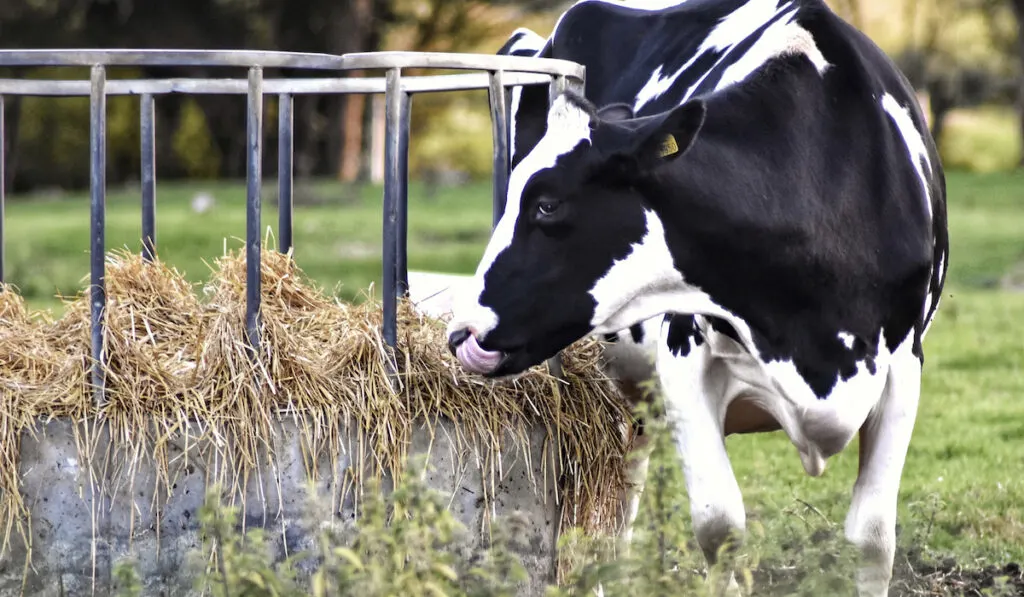
1. Holstein
The Holstein is a favorite amongst dairy farmers because of its outstanding milk production. They are easily recognizable because of their black and white patches, while the stylish Holstein also has a variety of black and red coloration with white patches.
History
This breed was originally a cross-breed of black Batavian cattle and white Friesian cows and was developed in Friesland (Currently Holland).
They were developed by dairy breeders who sought to have a breed that could produce more milk while consuming less feed, and for over 2000 years, they have been carefully bred for milk production. However, the breed was first introduced in the U.S. in 1852.
Characteristics
The Holstein is a polled large cow with distinctive black and white patches, and at times red. It has a 6-year productive lifespan but can live longer.
Uses
The Holstein has a large milk output and is specifically reared for milk production. At the peak of productivity, they can be milked three times a day and can produce over 72000 pounds of milk per year.
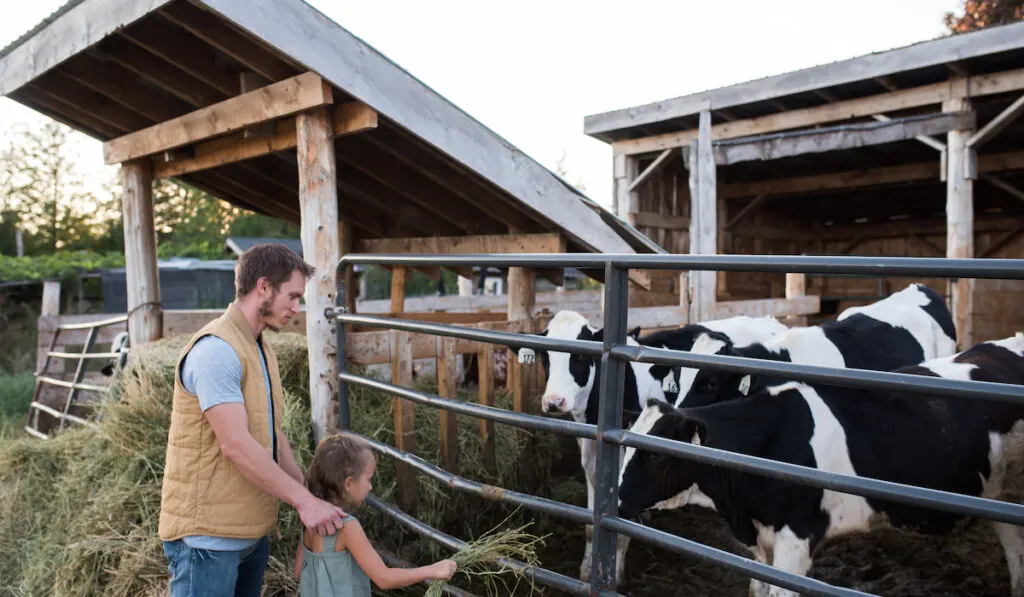
2. German Black Pied
The German Black Pied is one of the most popular black and white cow breeds. It has a stunning patterning on its coat that stands out and without even realizing it, just by its presence, the cow graces its environment with a satisfactory visual appeal.
History
Originally developed in the northern German and Dutch coasts along the north-sea, the German Black Pied is a result of three crossbreeds done in 1963, where Jersey bulls were crossed with German Black cows, and the resulting offspring further cross-bred with the Holstein.
Characteristics
Just like their predecessors, the German Black Pied cows have dominant black and white patches, but unlike the parents, they have a smaller body size, are more fertile, and have a long lifespan.
Uses
The German Black Pied has incredible milk and beef output and is primarily bred for both.
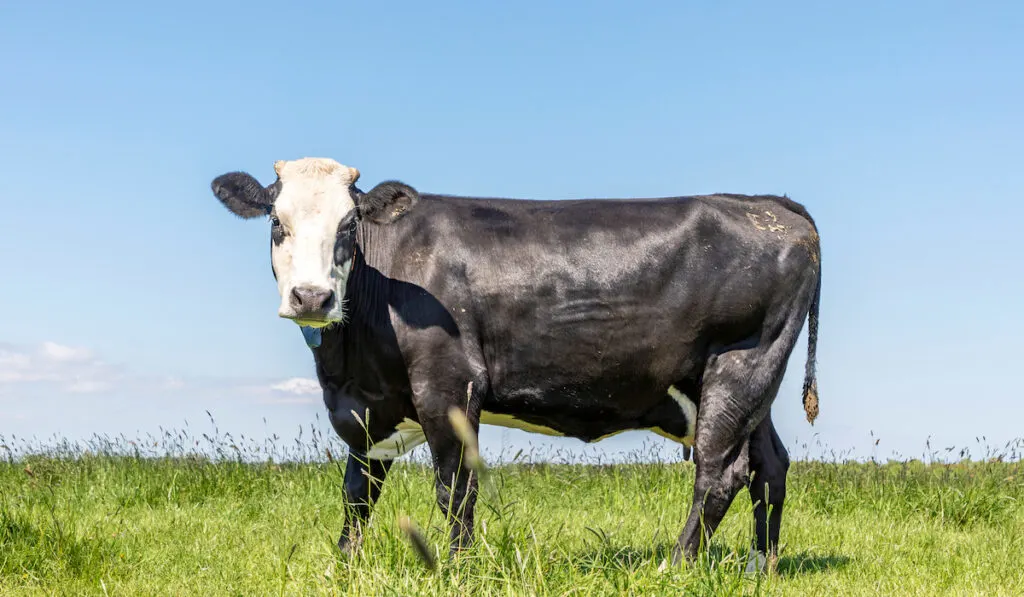
3. Blaarkop
Blaarkop is a unique black-and-white cow breed that stands out beautifully amongst the herd. ‘Blaarkop’ is a Dutch word meaning ‘blister head,’ basically describing the physical appearance and color patterning of the cow, usually with the head and belly having lighter colors (white), and darker elsewhere.
This cow’s unique color codes usually add visual interest to the environment.
History
With a history dating back to the 14th century, the Blaarkop is regarded as one of the oldest Dutch cattle breeds, and to this day, they are mostly bred in Groningen province in the Netherlands.
Their ancestors too can be traced back to medieval cattle.
Characteristics
As suggested by the name, this cow has color blisters or patches, usually white, around the eyes, head, and belly.
Among the other outstanding features include a medium-sized body, small and curved horns, a square head, a solid color coat with random white patches, and a tail with a white tip.
Uses
The Blaarkop is a multipurpose cow, usually reared for its amazing output of both milk and beef. Notably, both its products are equally popular amongst the consumers.
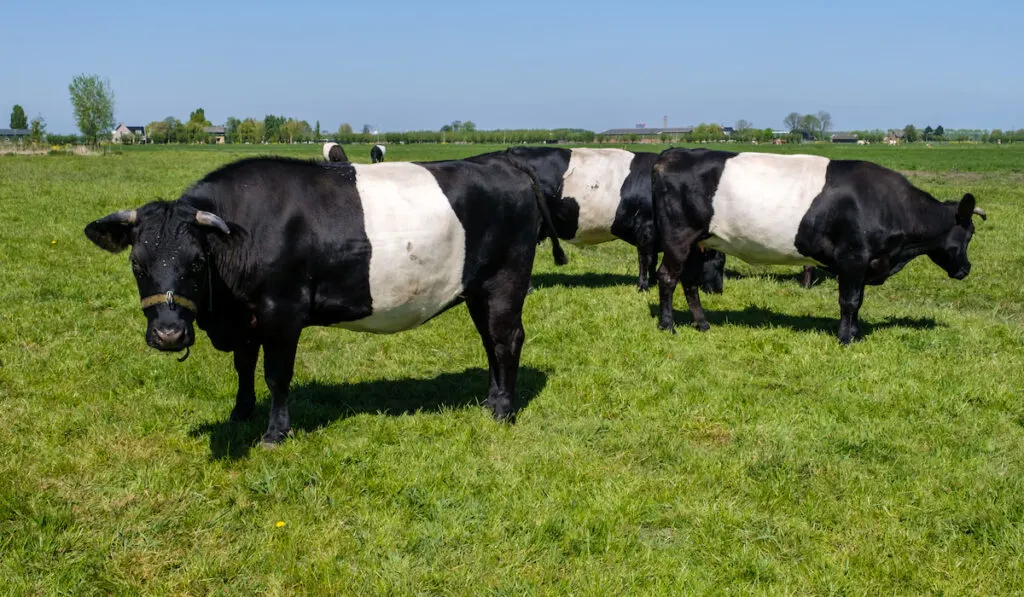
4. Lakenvelder
Also known as the Dutch Belted cow, the Lakenvelder is the only striped black and white cow whose ancestry can be traced and linked back to the original ‘canvassed’ cattle breeds.
This breed is also popular amongst cattle breeders because of the beautiful belted look which when crossed with other breeds, gives the popular “belt”.
History
The Lakenvelder is native to Switzerland and Austria but was first introduced to the Netherlands in the 17th century.
Since then, many local breeders and farmers started crossing their local cattle with the Dutch Belted to satisfy the growing demand for belted cows.
Characteristics
The main distinguishing feature of the Lakenvelder is the large white belt around the cow’s waistline. They also have a body structure most similar to dairy cattle and are naturally polled.
Uses
The Lakenvelder is a multipurpose cow breed. It has a large milk output that satisfies the needs of the dairy industry, but equally, owing to its stockier body, it produces high yields of beef.
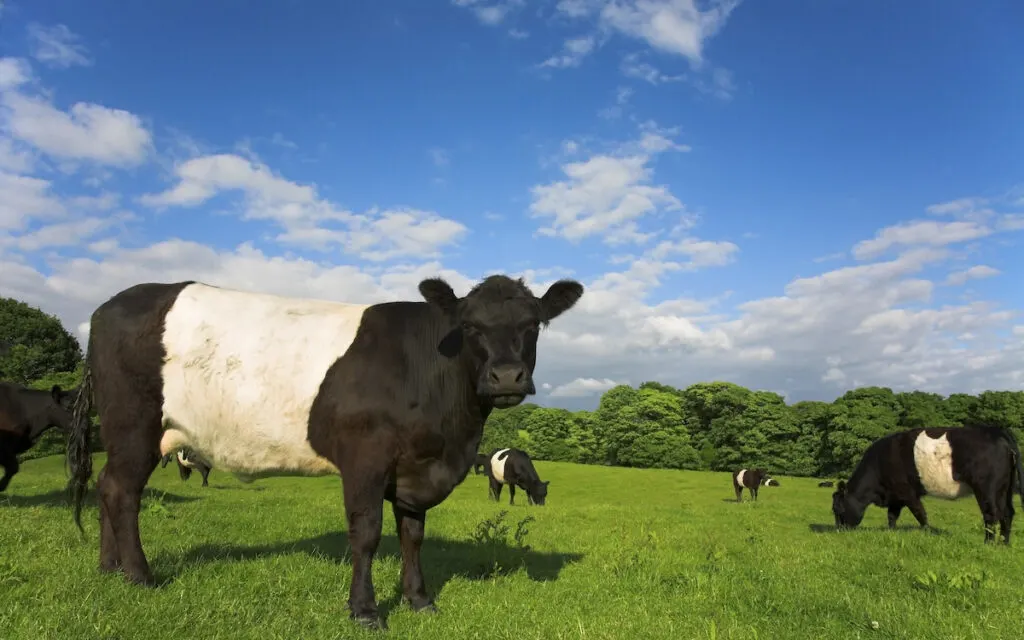
5. Belted Galloway
Also known as “Belties” or “Oreo cattle”, the Belted Galloway is a highly distinctive cow with a completely black body and head, except for the small strand of white fur running around the cow’s waistline like a belt, hence their name, ‘Belties.’
They are most popular in colder regions because of their double coat of hair that enables them to withstand extreme cold and the harshest winter.
History
The Belted Galloway is a Scottish breed believed to have been a cross between the Galloway and the Lakenvelder.
Characteristics
Their main distinguishing feature is the white belt that runs around the cow’s waistline. It also has a double coat of hair, is polled, medium-sized, and has high longevity.
Uses
The Belted Galloway is mainly reared for its lean and high-quality meat. Furthermore, they are known to be the very gentle, making them the most preferred for crossing because of this unique quality.

6. Girolando
The Girolando is a Brazilian breed most famous for its black and white coat color patterns. They are excellent foragers and do not need any feeding aid or frequent supplements. Because of this, they have a strong body build.
Furthermore, they are resistant to tropical diseases and are more adaptable to hotter climates.
History
Having been introduced in the 1940s, the Girolando is a bit new to the dairy cattle list. This hybrid was developed by the Brazilian breeders by crossing the local Brazilian Gyr and the Dutch Holstein to help meet the high milk demand in Brazil.
Characteristics
This hybrid combines the Holstein’s high yield abilities and the Gyr’s hardy nature and ability to withstand hot and arid climates.
They are often confused with the Holstein’s because of their high resemblance in body coloration, among others the strong legs and hooves, large ears, and an optimum udder capacity. However, their Gyr ancestry is still evident in their body posture and the shape of their skulls and backs.
They can have any coloring pattern but mostly have black backs and rumps with white undersides. The colors, however, meet in a gradual blending manner where the black and white gradually fade into each other until both sides are completely solid.
Uses
The Girolando is purely a dairy cattle breed. As mentioned before, they were developed in a bid to boost milk production and for this quality, they produce more than 80% of the total milk consumed in Brazil.
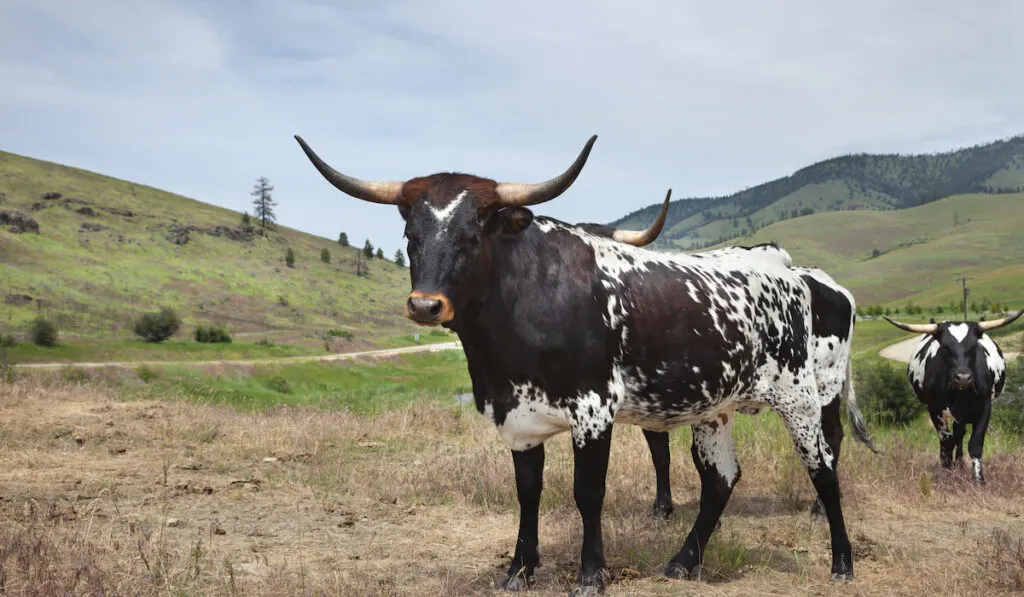
7. Texas Longhorn
As the name suggests, this breed is easily recognizable thanks to its long horns and distinctive black and white coat coloring. They are reared for a few reasons, mainly for their gentleness, intellect, economic value, and their genetic prospect.
History
The Texas Longhorn is a refined breed coming from a long line of crosses. Among its parent breeds are European Aurochs, Indicine cattle, and the Iberian Taurine.
Characteristics
Their coats are elegantly covered with black and white coat coloring with subtle striations. They also have extra-long horns that easily distinguish them from the herd. Among other features are high fertility, slow maturity, easy calving, and a lengthy reproductive cycle.
Uses
Longhorn’s beef has a good reputation for higher meat to fat ratio, making it good for health-conscious people. Apart from meat production, steers are also popular for riding competitions.
Conclusion
The above are just a few in an endless list of black and white cow breeds including the Brahman, Belgian Blue, British White Park, Panda cows, Dhanni, Yaroslavl cattle, Cholistani, Kerigarh, and many others.
They could be multipurpose or reared specifically for a single purpose. However, regardless of the breed, these black and white cow breeds all have one thing in common. They add a rare and elegant spectacle to their environment and often stand out amongst the herd.
Resources
- https://faunafacts.com/cows/black-and-white-cow-breeds/
- https://www.agriculture.com/family/living-the-country-life/16-common-cattle-breeds
- https://www.fondazioneslowfood.com/en/slow-food-presidia/lakenvelder-cattle/
- https://farmdesire.com/black-and-white-cow-breeds/
- https://www.thecattlesite.com/breeds/beef/18/texas-longhorn/
- https://www.britannica.com/animal/Holstein-Friesian
- https://www.thecattlesite.com/breeds/dairy/73/girolando/
- https://www.thecattlesite.com/breeds/beef/9/belted-galloway/
- https://www.roysfarm.com/blaarkop-cattle/
